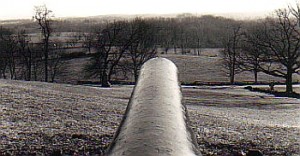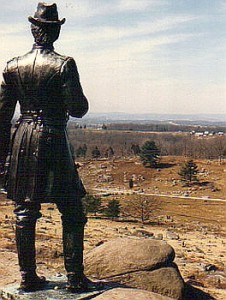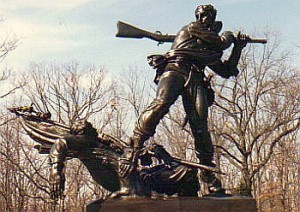In the early morning hours of a new day, when all is calm, a feeling of serenity permeates the air. As you walk through the dew-kissed fields in this small Pennsylvania town, it is difficult to imagine the bloodiest battle of the Civil War taking place here. Welcome to Gettysburg, where 51,000 Union and Confederate soldiers died in three days of intensive fighting July 1-3, 1863.

The Gettysburg battle is considered the turning point of the war that split the United States apart. After losing this battle, it was pretty much downhill all the way for the South.
When you visit Gettysburg, be sure to take guided walks over the battlefield with rangers from the National Park Service, which administers this battlefield. The park service offers more detailed walks, some led by historians, on the anniversary of the battle. If you hear cannons booming at this time, it’s the annual battle re-enactment taking place just outside the park. The Gettysburg Anniversary Committee sponsors this living history event on the site where the movie Gettysburg was filmed. Meet generals and soldiers, nurses and townspeople as they try to get through three days of hell.
2011 marks the 150th anniversary of the start of the Civil War that began on April 12, 1861, with shots fired on Fort Sumpter at Charleston, South Carolina.
What’s your history IQ when it comes to this war? See how many of these questions you can answer.
Gettysburg Addresses
Who was the keynote speaker at the dedication of the Gettysburg cemetery? If you said President Abraham Lincoln, you answered wrong. While we have long remembered the president’s simple two-minute speech, we have long forgotten that Edward Everett, a politician and minister, gave the two-hour keynote speech on November 19, 1863.
Two Names, One Battle
Two names apply to many battles fought between the United States and the Confederate States of America. What was the name the South used for Bull Run, a battle that occurred in northern Virginia? If you answered Manassas, go to the head of the class. What was the name the North used for the Battle of Sharpsburg in Maryland? Antietam. Earn a gold star if you know the significance of this battle. Answer: It was the first battle on Northern soil and the bloodiest single-day battle in U.S. history with 23,000 soldiers losing their lives on September 17, 1862. Gettysburg is the bloodiest multi-day battle.
Generals in Common
Besides commanding their respective armies, what did Union General Ulysses S. Grant and Confederate General Robert E. Lee have in common? Both are graduates of the U.S. Military Academy at West Point, New York, and both became presidents after the war. Grant, who graduated from West Point in 1843, became the 18th president of the United States. Lee, who graduated number two in the West Point class of 1829, became president of Washington College; the Lexington, Virginia, college was renamed Washington and Lee College after his presidency. Earn another gold star if you can name another Union general who also became president of the United States. James Garfield was inaugurated as the 20th president in 1881 and was assassinated a few months later.
A Brave Name

Confederate General Thomas Jonathan Jackson had a colorful nickname. What was it? Jackson earned the nickname of Stonewall for his bravery at the First Battle of Bull Run. Following the battle, another general commented, “There is Jackson standing like a stone wall.” Considered one of the greatest military tacticians in U.S. history, Jackson was accidentally shot by one of his men at the Battle of Chancellorsville, and died several days later at nearby Guinea Station. That site is now a part of the Fredericksburg and Spotsylvania National Military Park.
Name That Tune
Music, especially patriotic songs, has always been a part of any war. Can you name the songs that were popular during the Civil War? The Union had “The Battle Hymn of the Republic,” with its tune written in 1856 by William Steffie, but it was the lyrics, written in 1861 by social activist Julia Ward Howe, that made the song famous. Meanwhile, the Confederates marched to “The Bonnie Blue Flag,” written by Harry McCarthy in 1861 after Mississippi seceded from the Union. Can you name the Civil War tune that gained new popularity when it was recorded in the 20th century? Can you name the artist who made it famous? “Aura Lee” was sung by soldiers when they camped at night. The melody received new lyrics in the 20th century when it was recorded as “Love Me Tender” by Elvis Presley.
Your Results
If you answered all the questions correctly, go to the head of the class. You know your Civil War history. If you missed more than two questions, you might want to visit some of the sites mentioned here for a refresher course on the Civil War.
If you have several days, consider starting your Civil War tour at Gettysburg then driving south to Richmond, Virginia, the capital of the Confederacy. The distance is less than 200 miles, and could easily be done in a day, but why rush? You’ll want to spend at least a day at Gettysburg, then get on Interstate 15 to Frederick, Maryland. Detour north on Interstate 70 to visit the Antietam/Sharpsburg battle field. Return to Frederick and continue to Washington, D.C.

You can easily spend a week in our nation’s capital, but at least one day is mandatory to see sites associated with the Civil War and its personalities. There’s the Lincoln Memorial on the National Mall, and don’t forget to the National Archives, where you can see a copy of Lincoln’s handwritten Gettysburg Address and a photo of him just before he spoke. The archives also have military service records, so if you have ancestors who fought in the Civil War here’s the place to get their records. Before the war, General Lee lived in nearby Arlington, Virginia. His mansion is now a memorial located on the grounds of Arlington National Cemetery.

Not too far from Arlington is Manassas, site of the First and Second Battles of Bull Run/Manassas. History books tell of D.C. residents driving out for the day to watch the fighting at the first battle. Return to the freeway, this time Interstate 95, and head south to the battlefields at Fredericksburg and Spotsylvania and finally into Richmond. Several battlefields are located around Richmond, which is also home to the Museum and White House of the Confederacy. There you can see the uniform Lee wore at the surrender at Appomattox and the plumed hat worn by that dashing Confederate General Jeb Stuart.

